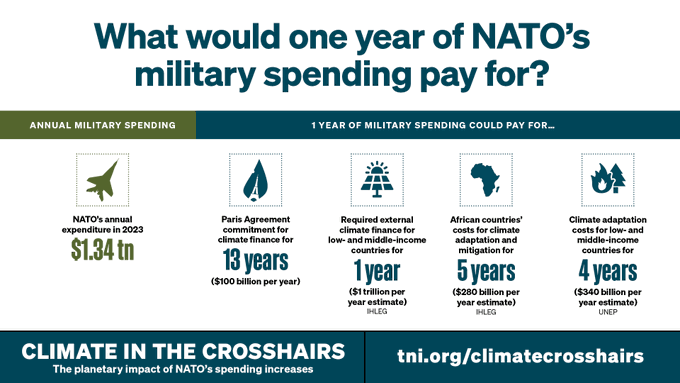
As NATO marks its 75th anniversary at its summit in Washington D.C. in July 2024, what will be the climate impacts of the world’s most powerful military alliance? Our new briefing ‘Climate in the Crosshairs‘, with Transnational Institute (TNI), Tipping Point North South, the International Peace Bureau (IPB), Veterans for Peace (US), Centre Delàs d’Estudis per la Pau and IPPNW Germany, shows that military spending increases greenhouse gas emissions, diverts critical finance from climate action, and consolidates an arms trade that fuels instability during climate breakdown.
Key findings:
- NATO’s overall military spending in 2023 of $1.34 trillion produces an estimated 233 million metric tonnes of CO2 equivalent (tCO2e). This is more than Colombia or Qatar’s annual GHG emissions.
- NATO’s military spending increase of $126 billion in 2023 will lead to an estimated additional 31 million metric tonnes of CO2 equivalent (tCO2e). This is equivalent to the annual CO2 emissions of around 6.7 million average US cars.
- The Intergovernmental Panel on Climate Change (IPCC) says that a 43% reduction in emissions is needed by all sectors by 2030 compared to 2019 levels to have a chance to keep global average temperature increases to below 1.5 degrees Celsius. This would require an annual reduction of military emissions of at least 5%, yet, NATO increased its military emissions by around 15% in 2023 and looks set to continue increasing emissions this decade.
- NATO’s increase of military spending in 2023 would pay for minimal climate financing demanded by developing countries in UN climate negotiations this year. NATO’s total military spending in 2023 would pay this 13 times over and start to deliver the trillions needed for climate finance.
- NATO claims a record two-thirds of its members will meet the target of 2% minimum GDP spending on the military (up from only six countries in 2021). If all members meet the commitment, by 2028 this would lead to a total estimated collective military carbon footprint of 2 billion tCO2e, greater than the annual GHG emissions of Russia. NATO would also spend an estimated additional $2.57 trillion, enough to pay for what the United Nations Environment Programme (UNEP) estimates as the climate adaptation costs for low- and middle-income countries for seven years.